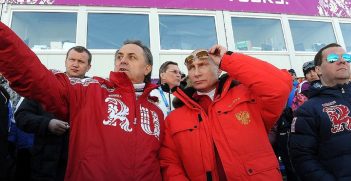Book Review: New Cold Wars – China's Rise, Russia's Invasion, and America's Struggle to Defend the West

The US has stumbled into at least two “New Cold Wars,” according to David Sanger. And as he writes, this was not supposed to happen, and there is no obvious or easy way out.
The end of the first Cold War was a time of great hope with narratives of “the end of history” and “peace dividend,” recalls David Sanger in his new book, New Cold Wars: China’s Rise, Russia’s Invasion, and America’s Struggle to Defend the West. According to Sanger, national security correspondent for the New York Times and bestselling author, Russia and China had strong economic incentives to sign up to the rules-based world order led by the US. Russia had a strong economic interest in keeping oil and gas flowing to Western markets. In China’s case, globalisation offered the opportunity for industrial growth and job creation.
But these were false assumptions about how international relations would play out. Today, in the wake of Russia’s invasion of Ukraine and America’s deteriorating relations with China, the US is facing two major adversaries. Compounding matters, these two countries have forged close bonds—something which President Richard Nixon and Henry Kissinger worked to avoid—and are now working closely with Iran and North Korea.
As Sanger laments, it is just a few years ago that China and Russia were collaborating with the US in negotiating the Iran nuclear deal to restrict Iran’s nuclear program (President Donald Trump withdrew the US from the deal in 2018). Further, in the early 2000s, China and Russia participated in the Six Party Talks aimed at ending North Korea’s nuclear program. Similar cooperation with China and Russia is unthinkable in today’s new Cold Wars.
Sanger reminds us that the original Cold War was a different beast. It was a two country, military and ideological, contest. Although there were terrifying moments like the Cuban missile crisis, over time a reassuring and predictable pattern developed. Each side was able to count the other’s nukes, and they could readily communicate via hot lines.
The old Cold War and the new Cold Wars do have similarities, hence the use of the Cold War moniker today. The US is pursuing “containment,” even though no US administration wants to use that phrase. But the new Cold Wars are a lot more complicated and dangerous, in part because there are simply more players, layers, and points of possible miscalculation. Today’s contest with China involves military, economic, financial, and technological competition,
Sanger goes to great lengths in recounting how the US found itself in the New Cold Wars. Underlying this narrative is the feeling that the US was blinded by its optimistic desire that China and Russia would quietly submit to the US-led rules-based world order. At every step along the way, US presidents of both parties were guided by poor intelligence, wishful thinking, and faulty assumptions. It was falsely imagined that China and Russia would reason, like Americans, that economics trumps territorial and other nationalist ambitions.
For his part, US President Bill Clinton had great faith that the Internet would undercut the authority of the Chinese Communist Party. In reality, China has proved expert at using digital technologies for social control, and to hunt down dissidents. Following the tragic 9/11 terrorist attacks, President George W. Bush worked closely with China and Russia on counter terrorism. But they then used this as cover for repressing domestic groups, notably the Uyghurs and Chechens.
The US was at times guilty of not listening, such as to Russian President Vladimir Putin’s speech at the 2007 Munich Security Conference, where he made very disparaging comments about the US power projection and the expansion of NATO. President Barack Obama’s administration took one whole year to implement weak sanctions in response to Russia’s seizure of Crimea in 2014, and would not provide arms to Ukraine.
What’s more, the next year German Chancellor Angela Merkel signed the agreement for Nord Stream II, a natural gas pipeline from Russia to Germany, on the basis that Putin was a “reliable supplier.” In all Sanger’s interviews, his interlocutors identified going soft on Russia’s seizure of Crimea as the biggest mistake in the West’s relations with Russia.
The other great misstep in the New Cold Wars was the misreading of Xi Jinping, who came to the Chinese leadership during the Obama administration. Intelligence reports suggested that Xi would not challenge US primacy in the Indo-Pacific, and that he would focus on the domestic economy. But the Xi who assumed the leadership of China around 2012/13 was a different person, focussing on repression at home, assertive international behaviour, and challenging US primacy.
It was only really under the Trump administration that the US started taking up the challenge of the New Cold Wars. H. R. McMaster, National Security Advisor from 2017 to 2018, wrote a new national security strategy proposing that relations with China and Russia, two revisionist and revanchist powers, rather than counterterrorism, be the US strategic priority. However, little was achieved by the Trump administration, which got bogged down in a trade war and Covid-19 blame game with China. Trump himself, meanwhile, resisted any proposition that Russia interfered in the 2016 presidential election.
Sanger argues that the disastrous US withdrawal from Afghanistan was a light-bulb moment for the Biden administration, which inspired its leadership of the Western support of Ukraine following the Russian invasion. Perhaps Biden’s most important work has been to rehabilitate relations with US allies, partners, and friends, especially through NATO. Sanger supports Biden’s policy of cutting off China’s access to the most advanced semiconductors, but believes that the administration’s efforts to rebuild America’s semiconductor manufacturing capacity are not sufficiently ambitious.
One of the most interesting stories in Sanger’s book concerns the role of the private sector in the Ukraine War. In response to the fear of Russian destruction of the Ukraine government’s IT systems, Microsoft and Amazon World Systems moved the entire government into the “cloud,” and Elon Musk offered his Starlink services. But then Musk refused a Ukrainian request to turn Starlink on for Crimea so that Ukraine could strike some Russian ships. Thus, there is a risk of private companies becoming important national security actors.
The US is at a real turning point now, concludes Sanger. The world wonders if the US has the staying power to help lead Ukraine to victory over Russia, and to lead the world beyond the Ukraine War. The US has the economic and technological power. But does it have the resolve to lead in a world of several adversaries (China, Russia, Iran, and North Korea), and where much of the rest of the world insists that it does not want to be pushed to choose. No-one is watching this more than China’s Xi Jinping.
Sanger’s new book is a work of “current history” of the past couple of decades, based on an impressive array of interviews. Although it covers much familiar territory, it offers rich details and insights, in a fast-paced and engaging narrative. It is one of few books on recent international politics that I would regard as a “must-read.”
This is a review of David Sanger’s New Cold Wars: China’s Rise, Russia’s Invasion, and America’s Struggle to Defend the West (Penguin House, 2024). ISBN: 9780593443590.
John West is the author of the book, Asian Century … on a Knife-Edge, which was reviewed in the Australian Outlook, and executive director of the Asian Century Institute. He has had a long career in international economics and relations, with major stints at the Australian Treasury, OECD, Asian Development Bank Institute, and Tokyo’s Sophia University.
This review is published under a Creative Commons License and may be republished with attribution.





